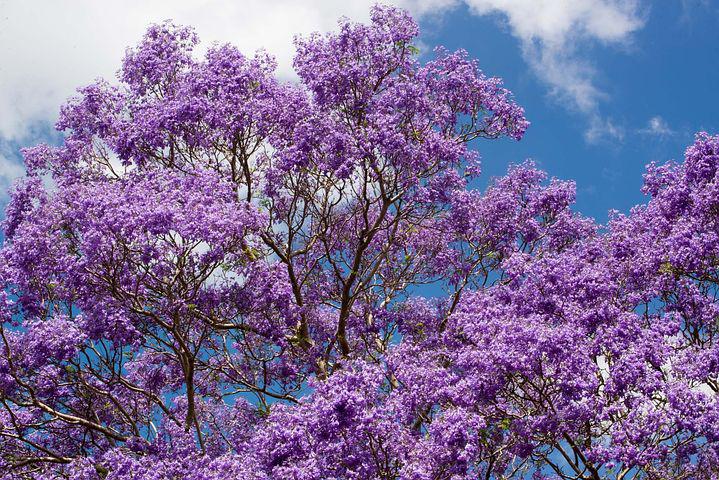By Patricia Jordan
At this time of year when I long to be cool I know that I can go indoors and put on the air con and cool down somewhat, but what about the garden?
Since the beginning of the year my garden has suffered extreme cold, continuous rain and sandy winds, and now temperatures reaching up to almost 40C and yet most mature plants have survived. Some short-lived plants can’t cope with such varying conditions like annuals, but my cacti, shrubs and trees seemed to have thrived on it all.
I have never seen so many flower stems on my Aloe vera plants. The now huge jacaranda trees, which I planted as young saplings almost 20 years ago and which my husband threatens to cut down as they are ‘messy’ trees, had an abundance of blossoms to my great delight and we had a bumper crop of eating oranges. The pelargoniums on my exposed veranda, which sit out there year in, year out and must be over 10 years old, have been a mass of bright pink flowers for months now and to cap it all my huge Agave americana Variegata in front of the house has thrown up an enormous flower shoot and we have had great delight in watching it grow day by day. I know that it will die after flowering, but the interest shown in our locality and on social media has been tremendous.
After our lovely, but oh so short, spring, it is good to have these stalwarts in our summer garden.
WHAT TO IN THE GARDEN IN JULY
Many roses that were so glorious in May and June will have had their first flush of flowers now and summer pruning is always a hot topic for discussion wherever I go. As I only grow ‘Banksia’ and ‘Damascena’ roses, both of which only have one flush of flowers a season, this isn’t a problem for me, but for those who grow bush and HT roses, a ‘prune’ after the first flowers have been picked or died, is essential.
Repeat flowering roses fall into two main categories – those described as ‘perpetual flowering’, as they continue to produce a succession of blooms throughout the summer months and those that only have two flowering seasons. Leaving dead flowers on the plant will delay the growth of any new flowering shoots, but don’t be too drastic, just cut off the stems with the dead roses to around two or three leaves behind the flowers. Next comes a resting period, when the bush tries to rejuvenate ready for the next flush of flowers, which should see you into the autumn. During this resting time, feed the bushes with a rose fertiliser if you can get it, or tomato fertiliser if not, both of which are rich in nitrogen and potash, which is what the plants need now. Fork this in around the base of the plant and water well. Some rose leaves succumb to black spot and other fungal diseases, so remove those as soon as you see them. The care taken now ensures that the plant is not straining to survive in the summer heat and come the slightly cooler weather in September and October, you may have many new blooms to welcome.
Along the coastline, trees with frondy leaves like Delonix regia and Albizia julibrissin are well able to cope with heat and humidity. The latter, fast growing drought-tolerant sub-tropical or tropical tree, originally from China and Western Asia, belongs to the legume family, meaning that it produces its seeds in pods. Grown mainly as an ornamental, it is also known as the ‘Persian silk tree’ or even the ‘ Chinese silk tree’. Supposedly, it was introduced into Europe in the mid-1800s and Persia too, hence one of its common names., The sweetly scented flowers appear in mid-summer and are most unusual as they have no petals, but clusters of perhaps ten or more long stamens resembling silk threads, hence its common names. They are generally pink or pink and white.
Plumeria (frangipani) grows along the coastline as well, revelling in the humid conditions, and is one of my favourite tropical trees from the time I lived in Singapore. However, at my elevation of 300 metres, these trees would not survive, more’s the pity, although I have tried to grow them here. Members of the Bignoniaceae family, Campsis radicans and Tecomaria capensis, come into their own during the summer months with the latter flowering through to the autumn into winter. Be careful where you plant the Campsis though, as it can grow to 10 metres high, leaping up and hooking itself onto telegraph poles or pergolas, which should be substantial as the weight of the vine could topple them. A near relative, Pyrostegia, such a useful plant and commonly known as the ‘Flame Vine’, will start to make flower buds, and will flower a little later in the year. This is another rampant plant and can cover a wall or shed in no time. Although these trees and climbers can cope with heat and humidity, don’t forget to water them occasionally.
At ground level, my favourite summer plants, agapanthus, which I wrote about last month, do best in a slightly shaded spot or their fleshy leaves will burn. Tulbaghias, from the rocky grasslands of South Africa with their pinky-lilac flowers that smell deliciously like hyacinths in the evening air, are bursting into flower. Some people don’t care for them as the roots have a rather oniony smell about them and they are sometimes known as ‘society garlic’, which people ate in those parts to repel insects, whilst Zulus grew these plants around their homes to deter snakes! The leaves are somewhat similar to chives, but tulbaghia flowers look like miniature agapanthus and are more attractive than those of chives.
If you haven’t managed to remove the dead leaves of any iris plants, do so without delay. Pull them off along the rhizome (the part that is above the ground), exposing it to the sun. You can even cut any remaining green leaves into a ‘V’ shape, about 10cm high, which lets the sun bake the rhizome more and in turn will help it to make the new flowers for next season.
Always water plants in the cool of the day, directing the water at the roots of the plants rather than over the whole plant. In the case of trees and large shrubs, a reminder that the feeding roots are not around the trunk, but between the trunk and the canopy of the tree. If you mulch potted plants, ensure that the soil is wet first, or the dry soil will be sealed in, and the plant may perish!
Keep a watering can next to the shower and save the first very cold water from that to help irrigate your potted plants, especially if you live in an apartment and ‘veranda garden’. You can also use any washing up water to irrigate plants and you may find that this ‘grey’ water will also deal with any insects! Someone to whom I gave this advice years ago said that her potted plants had never been so healthy and bug free! However, don’t use grey water for vegetables or salads! Remember that any hanging baskets and urns are totally dependent on you for watering at this time of year and when a hanging basket has been watered the weight will greatly increase, so make sure that the hook is strong enough. Group your potted plants together in the shade during periods when you are go away, so that your ‘help’ can water them all at the same time. Be aware that any garden hoses and filled watering cans left out in the sun at this time of year will contain very hot water, which may scald you or the plants, so take care.
Plant of the month – Thevetia peruviana
This pretty ornamental tree is from Central and South America where it is widely used in folk-lore medicine. It is often seen growing in the central reservations of motorways here and quite rightly too, for although it is an attractive plant, the little black berries are exceedingly poisonous and new plants can quickly grow from the scattered ripe seeds. All parts of the plant produce a highly poisonous latex, but the seeds are the most toxic!
Amongst its common names are ‘yellow oleander’ and ‘yellow bells’ and indeed it belongs to the same family, Apocynaceae, as oleander, frangipane and carissa. Growing to between 3 and 8 metres it is has long, lanceolate green leaves and bell-shaped flowers, which can vary in colour from bright yellow to soft orange and have a pleasant perfume. Originally found growing on the banks of watercourses, it can also grow well in a fertile, well-drained loam with additional leaf mould, though the trees can survive in rather poor and dry soils as well. Thevetia peruviana can be invasive in open areas and under light shade.








Click here to change your cookie preferences